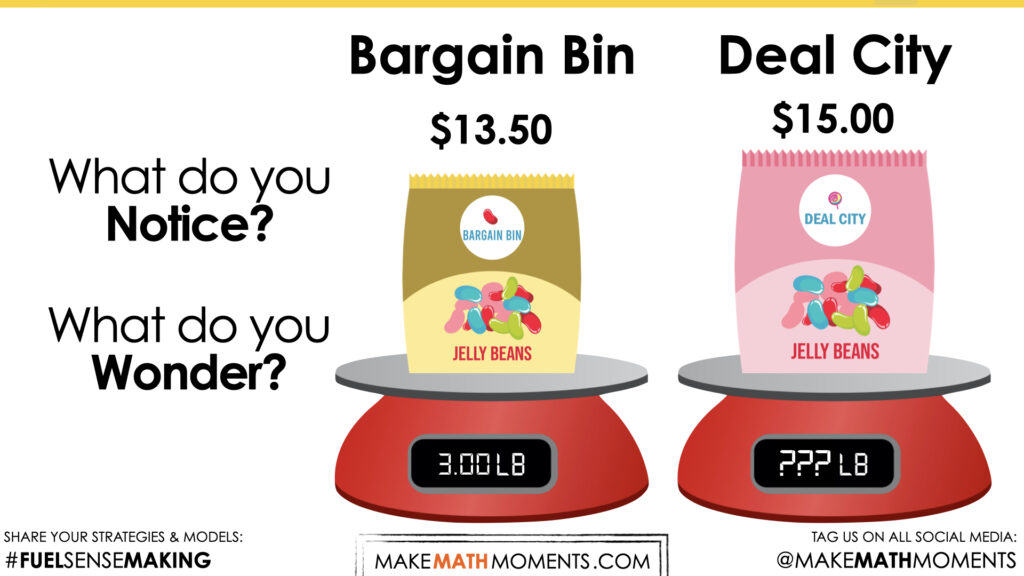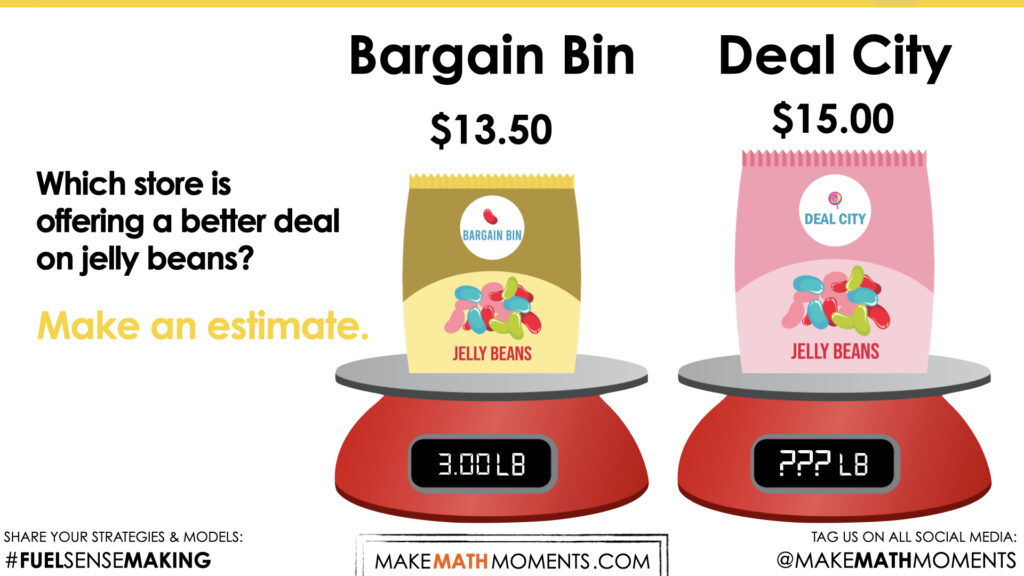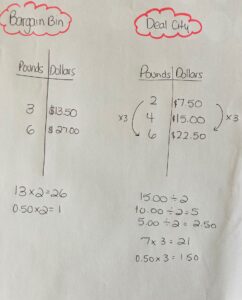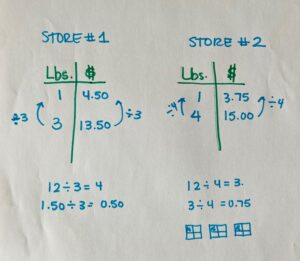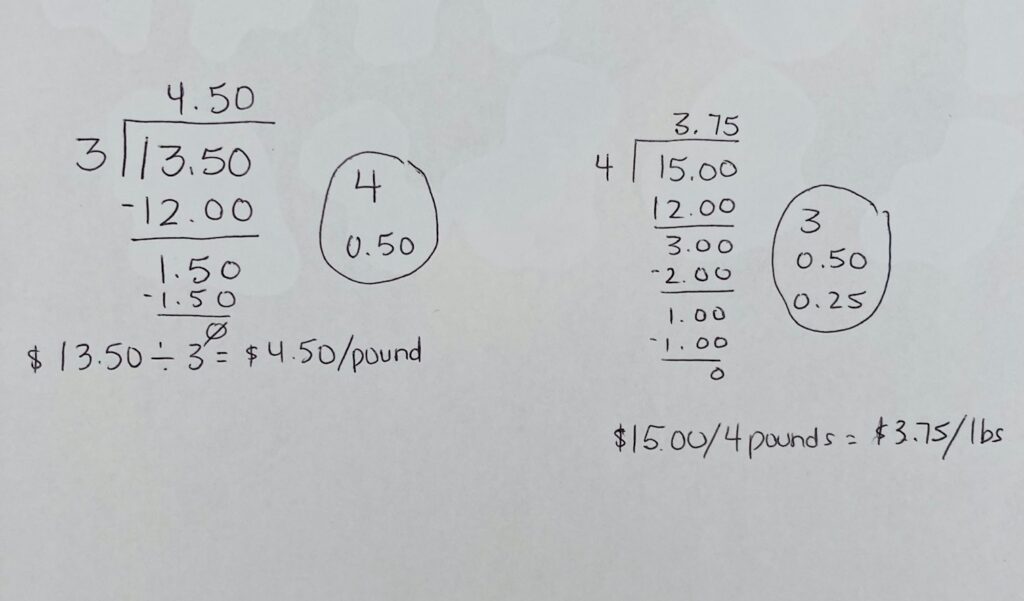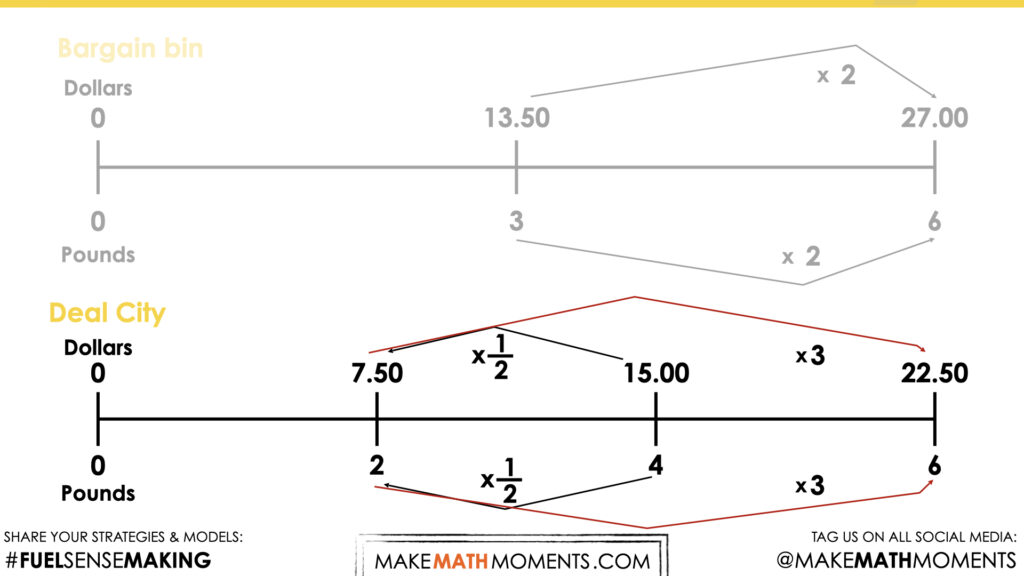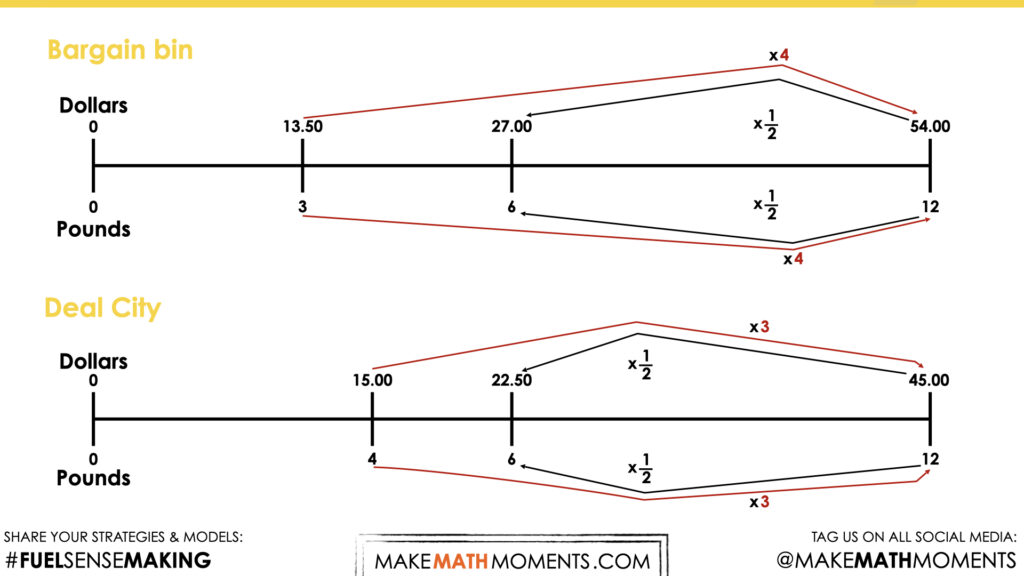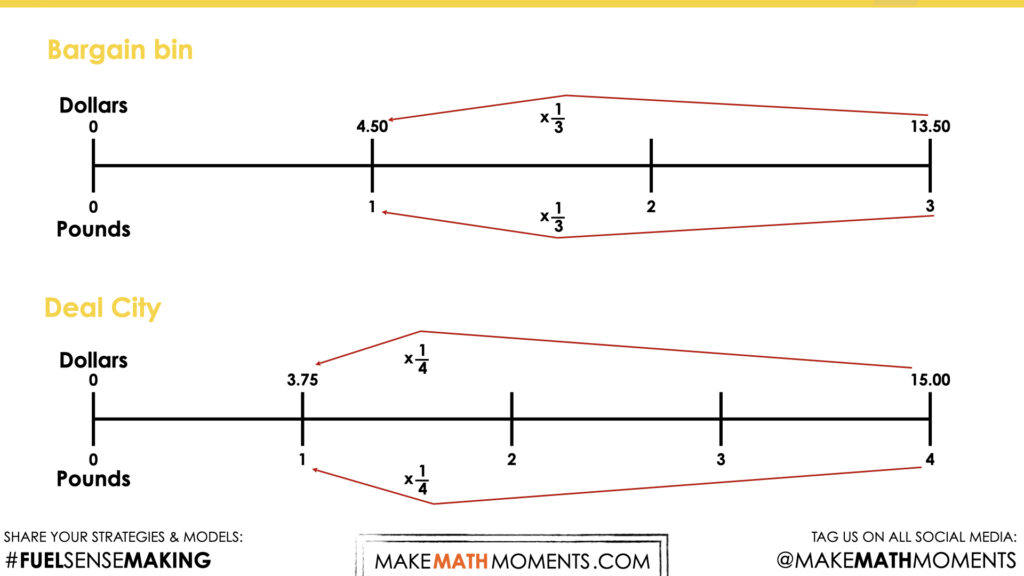BETTER BUY
PROPORTIONAL REASONING & FINANCIAL LITERACY
Use ratio reasoning and calculate rates for various goods to identify which rates offer the best value.
Intentionality
Spark Curiosity
Fuel Sensemaking
During Moves
Student Approaches
Next Moves
Consolidation
Reflect and Consolidation Prompts
Resources & Downloads
Educator Discussion Area
Intentionality & Unit Overview

Length of Unit: 5 Days
Access each lesson from this unit using the navigation links below
Students will determine which store is offering the best value for jellybeans.
Intentionality…
The purpose of this task is to give students an opportunity to apply their understanding of ratios and rates. Students will either scale the composed unit in tandem by revealing a scale factor, or leverage the rate that exists within this composed unit. Students will build fluency finding unknown values using ratio and/or rate reasoning for the purpose of comparison. Today’s task promotes consumer awareness as students determine the best value for their money when deciding between two stores to buy jelly beans. Some of the following big ideas may emerge in this task:
- There are two types of ratios; composed unit and multiplicative comparison;
- A composed unit is often (not always) a ratio with two distinct units;
- A composed unit can be scaled in tandem;
- When you divide a composed unit through partitive division, you reveal a rate;
- Composed units can be scaled to the same quantity of one variable in order to identify the “better buy”;
- Unit rates can be used to make direct comparisons in order to identify the “better buy”.
Prerequisite unit:
If your students do not currently have a solid understanding of the implications of division on ratio and rate reasoning, consider trying Planting Flowers before moving on to this unit.
Spark Curiosity
What Do You Notice? What Do You Wonder?
Show students this video:
Then, ask students:
What do you notice?
What do you wonder?
Ask students to engage in a notice and wonder protocol. ANYTHING and EVERYTHING that comes to mind is fair game.
Here’s some of the “everything and anything” students noticed and wondered on chart paper:
- I notice a scale.
- I wonder if this is at a grocery store.
- I notice some kind of colourful candy.
- I wonder if they are jelly beans.
- I notice 3 on the scale.
- I notice $13.50.
Estimation: Prompt
Student prompt:
Which store is offering a better deal on jelly beans?
Make an estimate.
Have students make predictions by reasoning through their comparison of the two stores through conversation alone.
Give students an opportunity to discuss their reasoning with a partner for about 2 minutes.
Take a vote from students on which store will offer the best value for jelly beans. Do not have students share their justification at this point, this may rob the thinking from fellow classmates.
Fuel Sense-making
Crafting A Productive Struggle: Prompt
Show students the following screenshot and follow-up with the prompt verbally:
You have been asked to purchase 6 pounds of jelly beans for a large event with a limited budget. Which store, Bargain Bin or Deal City is offering the best value for jelly beans? Where will you be shopping for jelly beans and why?
Use a model of your choice to convince your math community.
We will have students engage in this task without the aid of a calculator and thus we will promote the use of mathematical models as tools for thinking and representing their thinking.
During Moves
While Students Are Productively Struggling…
If students are using algorithms and procedures with symbolic notation, be sure that they are able to clearly communicate why their strategy works. If they are unable to, ask them to attempt modelling either concretely or visually/pictorially.
Monitor student thinking by circulating around the room and listening to the mathematical discourse. Select and sequence some of the student solution strategies and ask a student from the selected groups to share with the class from:
- most accessible to least accessible solution strategies and representations;
- most common/frequent to least common/frequent strategies and representations; or,
- choose another approach to selecting and sequencing student work.
Consider the strategies and models being used in order to plan your consolidation. Are students:
- Scaling both composed units to 6lbs?
- Scaling both composed units to 1 lbs?
- Revealing a unit rate through partitive division?
Are they modelling using:
- Number lines?
- Ratio tables?
- Symbolic representations?
Discuss their strategies and elicit student thinking during your consolidation to build off of their current prior knowledge and understanding rather than “fixing” or “funnelling” student thinking to a strategy and/or model that does not connect to their strategy and/or approach.
Student Approaches
Student Approach #1: Scaling up in the ratio table
I knew that at the first store, I could just double the 3 pounds to get to 6 pounds, so I doubled the price. The first store would cost $27.00 for 6 pounds of jelly beans. For the second store, I couldn’t just double 4 to get to 6 pounds, it is not a factor of 6. But 2 is a factor of both 4 and 6. I scaled back to 2 pounds by dividing by two, and then multiplied both the pounds and the dollars by three to get back to 6 pounds. The second store is a better value.
Student Approach #2: Scaling down in the ratio table
I knew that if I could get the price for one pound, I could compare them. I divided the first scenario by 3, and the second scenario by four to show the cost for one pound of jelly beans. In both cases, I decomposed the dollar value into $12.00 first and then worked with the rest to find the total cost for one pound. I used partial quotients to make the division easier.
Student Approach #3: Using partitive division to reveal a rate
I know that if I can divide the cost in dollars by the number of pounds, I can uncover the dollars per pound. I used a flexible algorithm to divide $13.50 by 3 and $15.00 by 4. I discovered that Deal City has a better rate. $3.75/lbs compared to $4.50/lbs.
Next Moves
Consolidation
The comparison of the quantities of pounds to dollars in this scenario is a specific type of ratio called a composed unit where one can consider the two quantities in the ratio as a single unit. For example, when we consider the 3 pounds and $13.50, we can view these two quantities together as one unit (composed of two unique units) that can increase and decrease in tandem (together).
Some students likely used the composed unit to scale the ratio up to 6 pounds or down to 1 pound in order to compare. Some students may have also scaled up to a common multiple of 3 and 4 such as 12, and then possibly divided by two.
We are going to call this strategy ratio reasoning.
Scenario 1:
Scenario 2:
Scenario 3:
A second strategy that may have been used is revealing a rate through partitive division. When we take the two quantities within a composed unit and divide through partitive division, a rate is revealed. A single quantity with a compound unit (dollar/pound or pound/dollar).
We are going to call this strategy rate reasoning.
Reflect and Consolidation Prompts
Provide students an opportunity to reflect on their learning by offering these consolidation prompts to be completed independently.
Consolidation Prompt #1:
Select one of the approaches shared during today’s consolidation that differed from your own. Explain how it worked. Use a model of your choice to communicate your understanding.
Consolidation Prompt #2:
A third store, Discount Den, is selling 5 pounds of jelly beans for $19.25. Is this a better deal than Deal City? Justify your answer.
We suggest collecting this reflection as an additional opportunity to engage in the formative assessment process to inform next steps for individual students as well as how the whole class will proceed.
Resources & Downloads
Printable Lesson Plan PDF
Videos, Images & Media Files
Apple Keynote Presentation
Powerpoint Presentation
Printable Consolidation Prompts
Educator Discussion Area
Login/Join to access the entire Teacher Guide, downloadable slide decks and printable handouts for this lesson and all problem based units.
Explore Our 60+ Problem Based Units
This Make Math Moments Lesson was designed to spark curiosity for a multi-day unit of study with built in purposeful practice, number talks and extensions to elicit and emerge strategies and mathematical models.
Dig into our other units of study and view by concept continuum, grade or topic!


